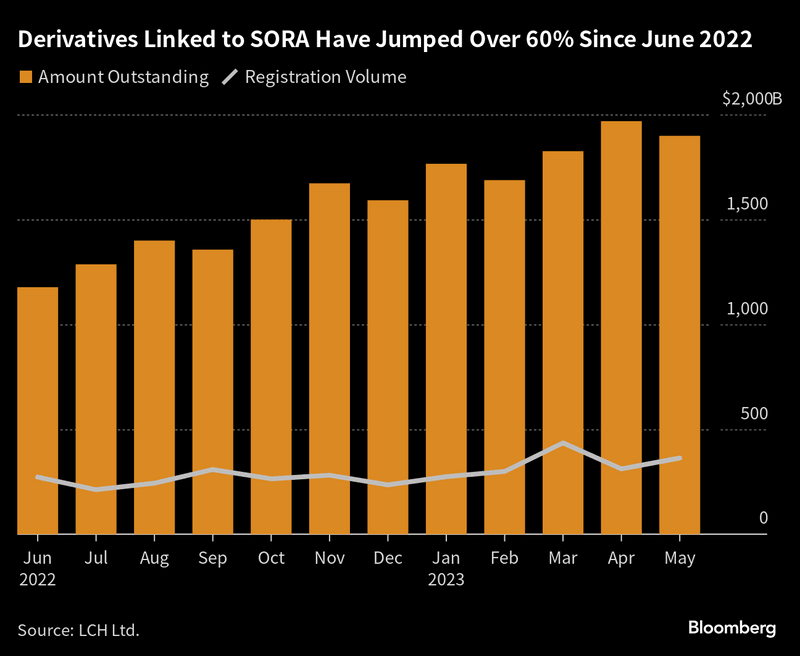This article was written by Ameya Karve with assistance from Tania Chen, Masaki Kondo, Paul Jackson, Aline Oyamada, and Daedo Kim. It appeared first on the Bloomberg Terminal.
- Outstanding SORA index swaps jumped to nearly $2 trillion: LCH
- Swaps pegged to new rate have risen over 60% from June 2022
Singapore’s financial markets have rapidly switched to a new lending benchmark as the city-state joins the world in saying goodbye to the discredited London interbank offered rate.
The outstanding value of index swaps pegged to the Singapore Overnight Rate Average — or SORA — climbed to almost $2 trillion at the end of May, more than 60% higher than in June 2022, data from clearing-house LCH Ltd. show. For loans, the total outstanding climbed to S$171 billion ($126 billion) in December, according to the local banking association.
The new gauge replaces the Singapore dollar swap offer rate, known as SOR. It got computed using LIBOR, which is being published for the last time on Friday.

“Singapore has been preparing for this transition and it should be a smooth one,” said Selena Ling, head of treasury research and strategy at Oversea-Chinese Banking Corp. “There is a robust infrastructure and process in place.”
Policymakers around the world have been introducing new gauges to replace LIBOR — a decades-old reference rate for bonds, loans and other forms of credit — following evidence from as early as 2008 that it had been manipulated by its contributing banks.
A number of non-US dollar LIBOR rates were discontinued in January 2022, and all remaining dollar LIBOR ones will cease to be published after June 30.
Since LIBOR was a global benchmark, getting rid of it is “chipping away a little bit further of the dollarization of the global economy,” said Stuart Cole, chief macro economist at Equiti Capital UK Ltd. While the shift take into account regulators’ concerns, “you’re going to get this continual fragmentation, and all that does is raise costs and destroy liquidity,” he said.
SORA, administered by the Monetary Authority of Singapore, is the volume-weighted average cost of borrowing Singapore dollars on the interbank market overnight. The gauge is based on actual trades, unlike LIBOR, which was liable to rigging because traders could submit fake bids.
A significant majority of derivatives tied to the SOR have now switched to SORA, MAS said this week.
SOR is an implied interest rate that relies on LIBOR input to reflect the cost of borrowing US dollars and converting them into local currency. The amount of outstanding SOR derivatives slid to S$400 billion in March from more than S$3 trillion in late 2019, while SOR corporate loans fell to S$21.7 billion from S$114 billion, the Association of Banks in Singapore said last month.

The Association of Banks also said it would discontinue SOR as planned after June 30, despite the UK Financial Conduct Authority’s announcement that it would require the publication of synthetic US dollar LIBOR until Sept. 30 next year.
All SOR users should aim to either actively transition away from the gauge, or insert appropriate contractual fallbacks into their contracts that mature after June 30, the association said. It released guidance on adjusting spreads for legacy debt tied to SOR earlier this month.
New guidance
“To our knowledge, there are no significant issues outstanding with regard to the approaches by which SOR exposures should be converted to SORA,” MAS said. Retail loans pegged to SOR were automatically converted to SORA in October last year.
The Singapore interbank offered rate — or SIBOR — another local lending rate similar to LIBOR that is most commonly used in the small- and medium-sized enterprise and retail loan markets — will be discontinued by the Association of Banks at the end of next year.
USD LIBOR transition in Asia
- South Korea’s Financial Supervisory Service said all but 2.8% of contracts with maturities after the expiry of LIBOR had fallback legal provisions in place
- The Monetary Authority of Singapore said LIBOR exposure needing corrective action has declined by more than 82% since January 2022, with an estimated S$144 billion remaining at the end of March. The bulk of this was in loans, a spokesperson told Bloomberg in June. MAS expects financial institutions will actively transition and not rely on synthetic LIBOR
- A Bank of Japan survey conducted in April and May found 90% of contracts — among them derivatives, loans and bonds — were expected to have transitioned by the end of June
- A Hong Kong Monetary Authority survey found HK$1.6 trillion ($204 billion) of assets and HK$400 billion of liabilities remained in the local financial system as of March. There were also derivatives with a notional value of HK$18.9 trillion